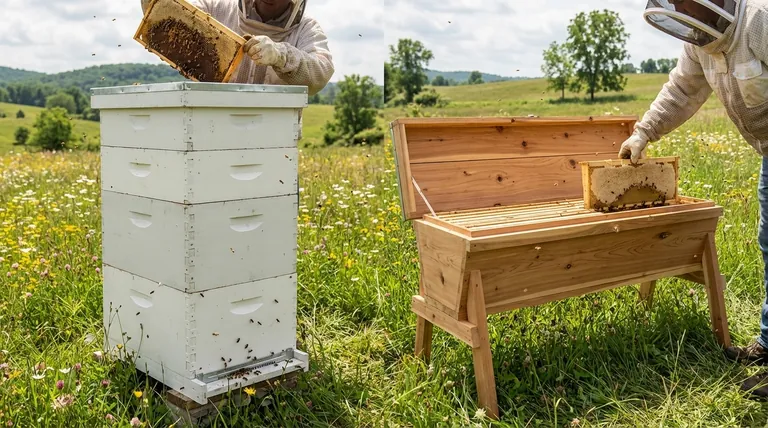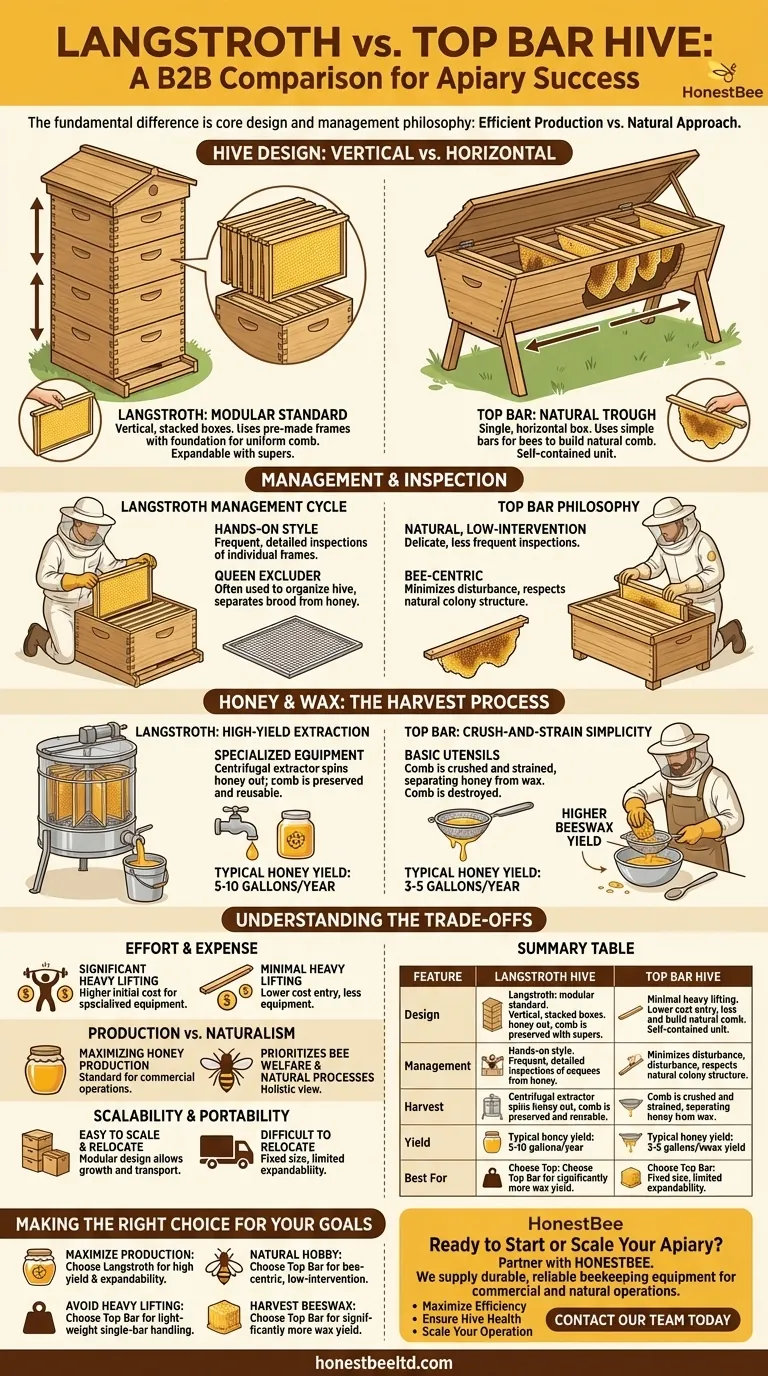The fundamental difference between a Langstroth and a top bar hive is their core design and management philosophy. A Langstroth is a vertical, modular hive using pre-made frames designed for efficient management and honey production, while a top bar hive is a single horizontal box that uses simple bars to encourage bees to build their own natural comb, prioritizing a less-invasive approach to beekeeping.
Choosing between a Langstroth and a top bar hive is not a question of which is "better," but which style of beekeeping aligns with your personal goals. The decision balances your desire for high honey yields against your interest in a more natural, low-intervention process.

Hive Design: Vertical vs. Horizontal
The physical structure of the hive dictates nearly every aspect of the beekeeping experience, from inspections to harvesting.
Langstroth: The Modular Standard
The Langstroth hive is the most recognizable design, consisting of vertically stacked rectangular boxes. Each box must have precise, standardized dimensions to ensure they fit together perfectly.
Inside these boxes are removable frames, which typically hold a sheet of foundation—a wax or plastic sheet imprinted with a honeycomb pattern. This foundation guides bees to build straight, uniform comb, making inspection and honey extraction predictable and efficient.
As the colony grows, the beekeeper adds more boxes (supers) to provide space for honey storage, making the hive highly expandable.
Top Bar: The Natural Trough
A top bar hive is a single, long horizontal box that sits on legs, often resembling a trough. It is a self-contained unit that does not expand vertically.
Instead of frames and foundation, this hive uses simple wooden bars that rest across the top. A small starter strip of wood or wax on the underside of each bar encourages bees to build their own natural comb downwards, just as they would in a hollow log. This gives the queen freedom to move and lay eggs across the colony without restriction.
Management and Inspection
Your day-to-day interaction with the bees is profoundly different depending on the hive you choose.
The Langstroth Management Cycle
Langstroth hives require a more hands-on management style. Inspections involve opening the hive and pulling out individual frames to check on the queen, look for pests like varroa mites, and assess brood health.
Management often involves using a queen excluder, a screen that keeps the larger queen in the lower boxes (brood chamber) while allowing worker bees to pass through to the upper honey supers. This organizes the hive for the beekeeper but can disrupt the bees' natural behavior.
The Top Bar Philosophy
Top bar hives are designed for a more natural, low-intervention approach. Because the comb is fragile and not supported by a full frame, inspections are typically less frequent and more delicate.
Beekeepers usually only lift one bar at a time, minimizing disturbance to the rest of the colony. The philosophy is often described as "bee-centric," letting the colony manage its own space and structure with less interference.
Honey and Wax: The Harvest Process
The method of harvesting honey is a key differentiator and directly impacts your final yield of both honey and beeswax.
Langstroth: High-Yield Extraction
Harvesting from a Langstroth hive requires specialized equipment, including a centrifugal extractor. The wax cappings are sliced off the frames, which are then spun in the extractor to pull the honey out without damaging the comb.
Because the comb is preserved, bees do not have to expend energy rebuilding it the following season. This is the primary reason Langstroth hives have a much higher honey yield, typically producing 5 to 10 gallons annually.
Top Bar: Crush-and-Strain Simplicity
Harvesting from a top bar hive is a simpler process that requires basic kitchen utensils. The beekeeper cuts the entire comb off the bar, crushes it, and strains it through a sieve or cheesecloth to separate the honey from the wax.
This crush-and-strain method destroys the comb, forcing the bees to rebuild it from scratch. This energy expenditure results in a lower honey yield of 3 to 5 gallons a year. However, it produces a much larger quantity of clean beeswax, which can be a valuable secondary product.
Understanding the Trade-offs
Neither hive is perfect. Your choice involves balancing physical effort, cost, and your ultimate goals as a beekeeper.
Effort and Expense
Langstroth hives require significant heavy lifting, as a full super of honey can weigh over 50 pounds. You also need to invest in more specialized and expensive equipment, like an extractor.
Top bar hives eliminate heavy lifting, as you only ever handle one bar at a time. The initial setup and harvest process require minimal equipment, making it a less expensive entry point into beekeeping.
Production vs. Naturalism
The core trade-off is between production efficiency and a natural approach. The Langstroth is built for maximizing honey production and is the standard for any commercial or semi-commercial operation.
The top bar hive is favored by those who prioritize bee welfare and natural processes over yield. It offers a more holistic view of the colony as a superorganism.
Scalability and Portability
The modular design of a Langstroth hive makes it easy to scale up and relatively easy to move for pollination or to find a better location.
A top bar hive is a single large unit that is more difficult to relocate. Its fixed size also means it cannot be expanded to accommodate an exceptionally large honey flow in the same way a Langstroth can.
Making the Right Choice for Your Goals
Your ideal hive depends entirely on what you want to achieve with beekeeping.
- If your primary focus is maximizing honey production: Choose a Langstroth hive for its high yield, reusable comb, and industry-standard expandability.
- If your primary focus is a natural, low-intervention hobby: Choose a top bar hive to enjoy a more bee-centric process with less invasive management.
- If you have physical limitations or want to avoid heavy lifting: Choose a top bar hive, as you will only ever need to lift a single, lightweight bar.
- If you are interested in harvesting significant amounts of beeswax: Choose a top bar hive, as the crush-and-strain harvest method yields far more wax.
Ultimately, the best hive is the one that aligns with your resources, physical ability, and personal beekeeping philosophy.
Summary Table:
| Feature | Langstroth Hive | Top Bar Hive |
|---|---|---|
| Design | Vertical, modular boxes with frames | Single, horizontal box with bars |
| Management Style | Hands-on, frequent inspections | Low-intervention, delicate inspections |
| Honey Harvest Method | Extractor (reusable comb) | Crush-and-strain (destroys comb) |
| Typical Honey Yield | 5-10 gallons per year | 3-5 gallons per year |
| Best For | Maximizing honey production, scalability | Natural beekeeping, less physical effort |
Ready to Start or Scale Your Apiary? Partner with HONESTBEE.
Whether you're a commercial apiary aiming for maximum honey yield with Langstroth hives or a distributor promoting natural beekeeping with top bar hives, having the right, high-quality equipment is fundamental to success. HONESTBEE supplies durable, reliable beekeeping supplies and equipment through our wholesale-focused operations.
We help you:
- Maximize Efficiency: Get the precise equipment you need for your chosen beekeeping method.
- Ensure Hive Health: Source from a trusted supplier known for quality and durability.
- Scale Your Operation: Access wholesale pricing and reliable supply chains for commercial growth.
Let's discuss your specific needs. Contact our team today to get the right equipment for your beekeeping philosophy.
Visual Guide

Related Products
- Long Langstroth Style Horizontal Top Bar Hive for Wholesale
- Professional Hive Top Bee Feeder for Beekeeping
- HONESTBEE Professional Hive Top Bee Feeder Feeding Solution
- HONESTBEE Advanced Ergonomic Stainless Steel Hive Tool for Beekeeping
- Ergonomic Two Person Foldable Hive Lifter
People Also Ask
- What are the box management requirements for a top bar hive vs. Langstroth? Choose Your Hive Strategy
- What are the most popular types of hives besides the Langstroth? Top Bar & Horizontal Hives Explained
- How are entrances designed in top bar hives? Master Beehive Layout for Maximum Honey
- How does the top bar hive help control varroa mites? A Natural Approach to Mite Management
- What are the benefits of a top bar hive? A Natural, Low-Impact Approach to Beekeeping



















